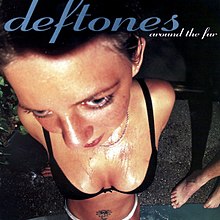Around the Fur
| Around the Fur | ||||||||||
|---|---|---|---|---|---|---|---|---|---|---|
 |
||||||||||
| Studio album by Deftones | ||||||||||
| Released | October 28, 1997, May 17, 2011 (vinyl) | |||||||||
| Recorded | April–June 1997 | |||||||||
| Studio | Studio Litho, Seattle, Washington | |||||||||
| Genre | ||||||||||
| Length | 73:55 (41:45 without hidden tracks or on vinyl) | |||||||||
| Label | Maverick/Warner Bros. | |||||||||
| Producer |
|
|||||||||
| Deftones chronology | ||||||||||
|
||||||||||
| Professional ratings | |
|---|---|
| Review scores | |
| Source | Rating |
| AllMusic | |
| Pitchfork | 7.8/10 |
| Punknews.org | |
| Robert Christgau | |
Around the Fur is the second studio album by American alternative metal band Deftones, released in 1997 by Maverick Records. The songs "My Own Summer (Shove It)" and "Be Quiet and Drive (Far Away)" were both released as singles with accompanying videos. It was their first RIAA-certified album, certified gold in June 1999, with predecessor Adrenaline also certified gold a few weeks later. The album was eventually certified platinum on June 7, 2011.
On Around the Fur, Deftones shifted away from the sound of their debut, using elements of genres such as new wave and shoegaze. The album has also been described as alternative metal,nu metal and alternative rock.
Around the Fur was the second album to feature Frank Delgado under additional personnel; he eventually joined the band officially in 1999.
The song "Headup" featured additional vocals by Max Cavalera of Soulfly. It was written by Cavalera and Deftones singer Chino Moreno as a way of venting some of their pain over the loss of Dana Wells, Cavalera's stepson and Chino's friend. The band name "Soulfly" was taken from a portmanteau invented for the song.
While the album's lyrics were included in the booklet, not every single word was printed. A good example is the song "Lhabia": In the verses, Moreno whispers statements that are hard to decipher. There is also one verse missing from the song "Headup".
The album cover was shot by photographer Rick Kosick during a late-night party in Seattle where the band was recording. Upon seeing the candid photo of a woman, the band decided that they wanted to use it as the album cover. Kosick was unsure who the woman was, so the band had to find and track her down to obtain permission to use the photo, which she eventually granted. Moreno has since expressed his dislike of the cover, calling it "horrible".
...
Wikipedia
